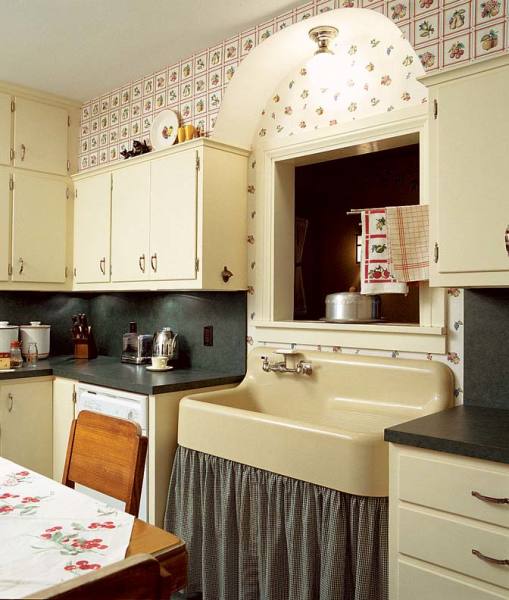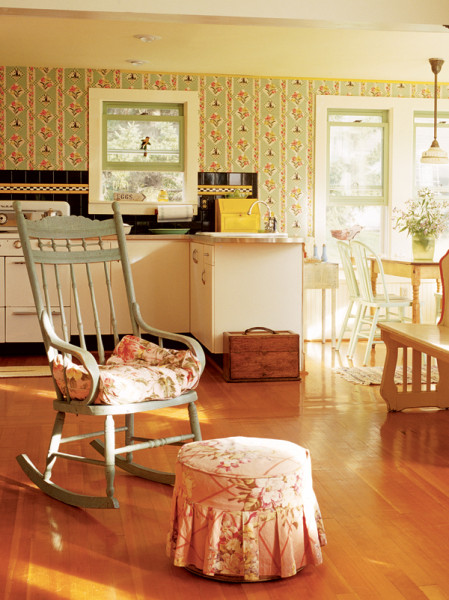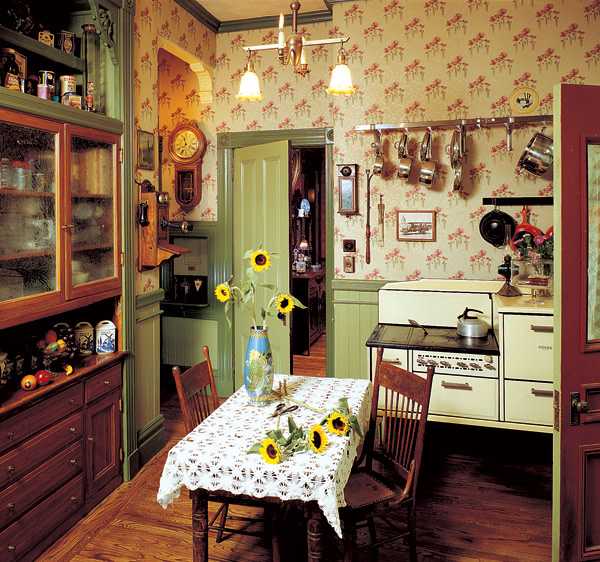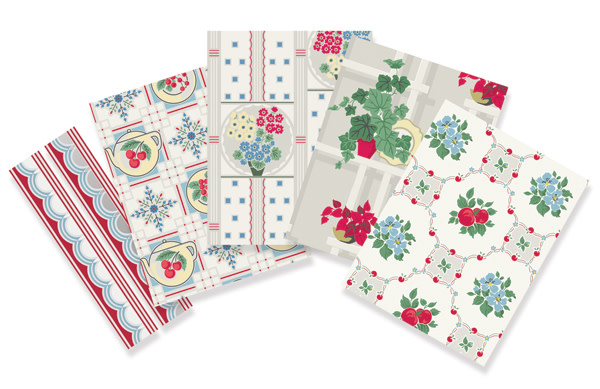The fruit-cluster wallpaper (an old Sherwin-Williams pattern) is perfect for this re-creation of a pre-war kitchen. (Photo: Eric Oxendorf)
Ask a design historian if wallpaper was used in period kitchens, and the answer will be, “It depends.” You’ll get the same response if you ask whether the idea is even practical. Wallpapered kitchens were rare before the electric era, for reasons that should be obvious. First, kitchens were historically smoky, greasy rooms that were kept spare and easy to clean. Then, people did not spend money decorating rooms not seen by guests.
Shelves may have been papered, or a butler’s pantry, or a breakfast room. There are other exceptions dating to Victorian times. Contrary to convention, wallpaper was more likely to be found in a rural or poor kitchen. During the pre-electric era, kitchens in wealthier homes were the province of servants. Urban kitchens often were kept out of sight, in the rear basement, to contain heat and smells and to provide easy access to deliveries. No one would have thought to wallpaper such rooms. In rural farmhouses, however, as in tenement apartments, the kitchen might well have been wallpapered with a design chosen by the housewife who spent time in the room.
A naïve windmills-and-tulips-motif paper (discontinued) adds country charm to a kitchen that opens to a dining area. (Photo: Gross & Daley)
The “sanitary” white kitchens of the bungalow era rarely were papered, either. Easy-to-clean gloss paint and ceramic tile were standard finishes. Again, an exception might be made in an eating nook, or out of the way of spills, as on a soffit or the archway over the sink. By the 1930s, inexpensive papers printed with “kitchen motifs” were available. Designs included sprays of flowers or cherries, often with a geometric background; fruit arranged in clusters or in colored stripes; naïve arrangements of windows or plates.
Wallpapered kitchens were very popular after the war, during the 1940s and throughout the 1950s. If you don’t remember mid-century kitchen wallpaper from your own childhood, you’ve probably come across it stripping a wall. Roosters were wildly popular, as were other nostalgic farm motifs like orchard trees and vegetables. Repetitive geometric designs were rendered in bright colors like pink and turquoise, or yellow with cornflower blue. Cherries or geraniums were superimposed on stripes and polka dots; old-fashioned crank coffee grinders alternated with urns and cups. Flower sprays, flowerpots, strawberries, and teapots were ubiquitous. A few of these wallpaper designs were bold and charming. Many are best forgotten.
An old butler’s pantry in an 1889 Victorian house was remade as the kitchen proper; the poppy wallpaper is a document reproduction. (Photo: Linda Svendsen)
Although durable-finish brands like Sanitas Wallcoverings had been around since the 1920s, vinyl wallcoverings were introduced in the 1950s and ’60s. Because they were sold as scrubbable, many of their designs were meant for kitchens and bathrooms.
Today we use gas and electric, not coal. Stoves have exhaust hoods, and food preparation is minimal. Practical reasons for avoiding wallpaper in the kitchen have faded. In fact, Revival kitchens often rely on wallpaper to lend period color and pattern to the room, as in the three re-created Victorian kitchens shown in this article. And nothing adds cottage charm to a kitchen like a retro-style wallpaper. If you’re conjuring up a Depression-era or postwar kitchen, you can choose wallpapers from sources that sell old stock—or from companies once again producing 20th-century designs.
Teapot, cherry, apple Betty: late 1940s kitchen papers from Bradbury & Bradbury.
Used near or above a stove, paper will eventually discolor. You can make it somewhat washable by coating it with matte-finish polyurethane. Better yet, rely on stone and laminates, tile and semi-gloss paint in the working part of the kitchen. Add color and period style by wallpapering facing walls, the breakfast area, back hall, or pantry.







